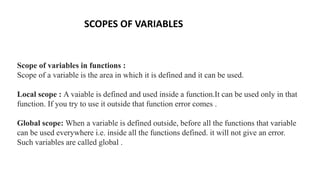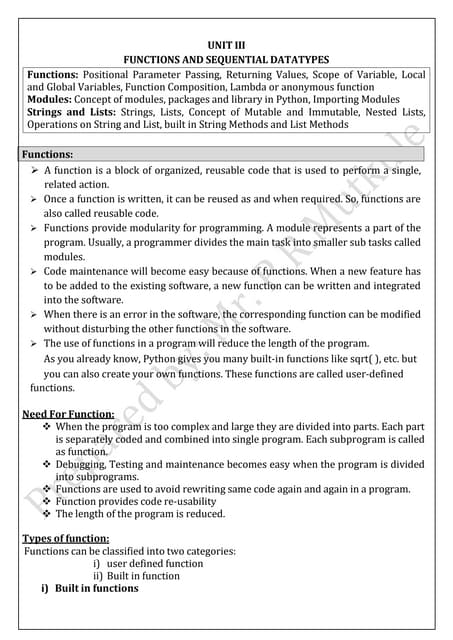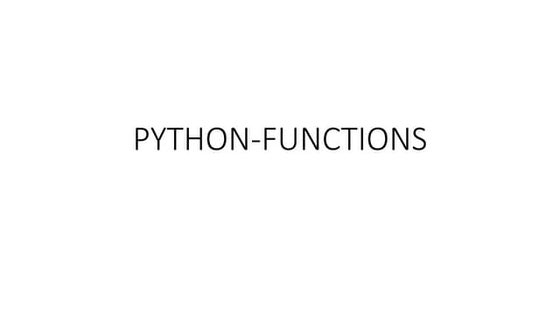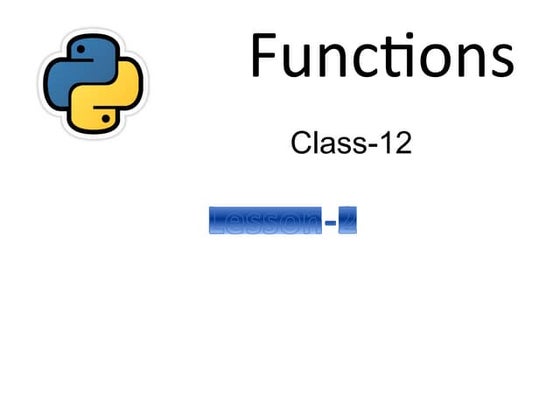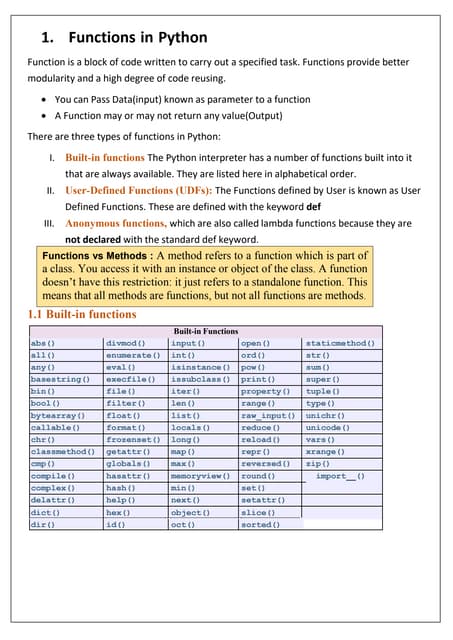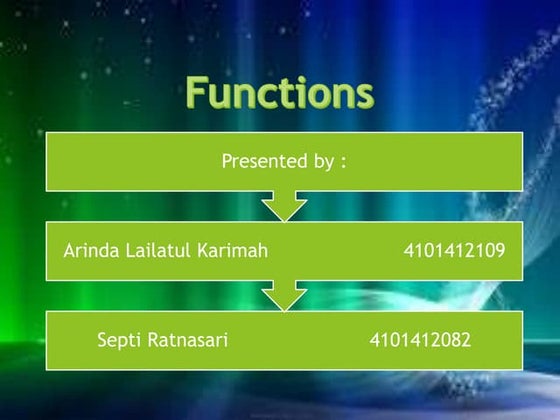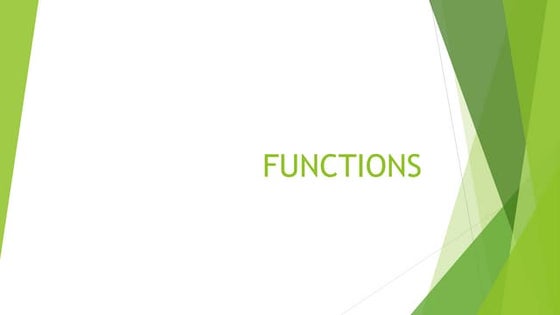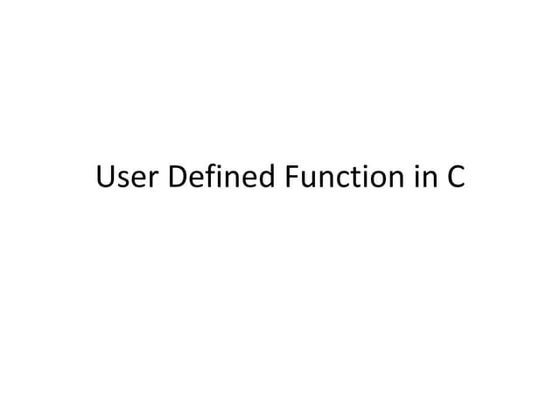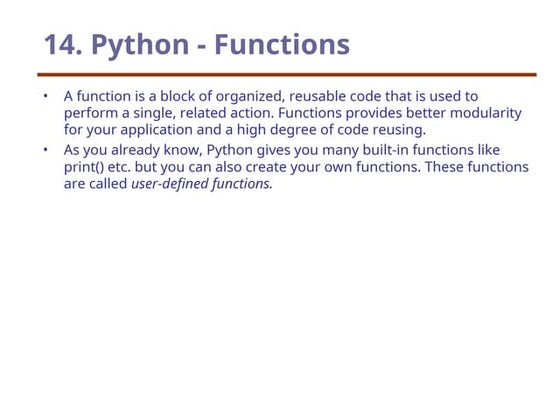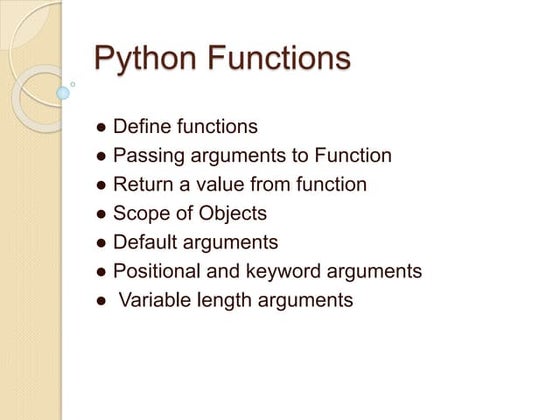Userdefined functions brief explaination.pdf
- 2. Unit I: Computational Thinking and Programming ŌĆō Revision of Python topics covered in Class XI. Functions: types of function (built-in functions, functions defined in module, user defined functions), creating user defined function, arguments and parameters, default parameters, positional parameters, function returning value(s), flow of execution, scope of a variable (global scope, local scope) Introduction to files, types of files (Text file, Binary file, CSV file), relative and absolute paths Text file: opening a text file, text file open modes (r, r+, w, w+, a, a+), closing a text file, opening a file using with clause, writing/appending data to a text file using write() and writelines(), reading from a text file using read(), readline() and readlines(), seek and tell methods, manipulation of data in a text file Binary file: basic operations on a binary file: open using file open modes (rb, rb+, wb, wb+, ab, ab+), close a binary file, import pickle module, dump() and load() method, read, write/create, search, append and update operations in a binary file CSV file: import csv module, open / close csv file, write into a csv file using csv.writer() and read from a csv file using csv.reader( ) Data Structure: Stack, operations on stack (push & pop), implementation of stack using list.
- 3. Revision of Python topics covered in Class XI. ŌĆó Datatypes ŌĆó Operators ŌĆó Errors ŌĆó Flow of Control : if else construct ŌĆó Loops : For and While loop ŌĆó Strings ŌĆó List ŌĆó Tuples ŌĆó Dictionary ŌĆó Python modules : math , random, statistics
- 4. Functions: types of function (built-in functions, functions defined in module, user defined functions), creating user defined function, arguments and parameters, default parameters, positional parameters, function returning value(s), flow of execution, scope of a variable (global scope, local scope) A function is a block of code which only runs when it is called. You can pass data, known as parameters, into a function. A function can return data as a result. In Python a function is defined using the def keyword. Syntax : def my_function(): print("Hello from a function") my_function()
- 5. Arguments Information can be passed into functions as arguments. Arguments are specified after the function name, inside the parentheses. You can add as many arguments as you want, just separate them with a comma. Parameters or Arguments? The terms parameter and argument can be used for the same thing: information that are passed into a function. From a function's perspective: A parameter is the variable listed inside the parentheses in the function definition. An argument is the value that is sent to the function when it is called. Parameters or Arguments?
- 6. def sum(x,y): sum=x+y print("sum=",sum) a sum("5","7") def sum(x,y): sum=x+y print("sum=",sum) sum(5,7) Output : sum= 57 Output : sum= 12 A parameter is a variable in a method definition. When a method is called, the arguments are the data you pass into the method's parameters. Parameter is va riable in the declaration of function. Argument is the actual value of this va riable that gets passed to function. When a method is called, the arguments are the data you pass into the method's parameters. Parameter is variable in the declaration of function. Argument is the actual value of this variable that gets passed to function. Examples for Parameters and arguments 5, 7 are arguments x,y are parameters
- 7. TYPES OF ARGUMENTS : Positional Arguments , Default Arguments positional arguments are those arguments which are passed to a function in correct positional order One parameter mentioned Passing two arguments Error generated
- 8. DEFAULT ARGUMENTS :Sometimes we may want to use parameters in a function that takes default values in case the user doesnŌĆÖt want to provide a value for them. For this, we can use default arguments which assumes a default value if a value is not supplied as an argument while calling the function. In parameters list, we can give default values to one or more parameters.
- 9. As its positional passing first argument goes to first parameter which is a. It wonŌĆÖt give error as b already has a default value
- 10. Using a non-default argument after default arguments raise a SyntaxError. In Python functions, a default argument can only be followed by a default argument. Important : Non-default arguments must be placed before default arguments. REASON : In function, the values are assigned to parameters in order, by their position. The value of default argument may be optional as there is the default value if not provided, but the value for a non- default argument is mandatory as there exists no default value for this CodeText As its positional passing first argument goes to first parameter which is a. As there is no second argument passed and b does not have a default value it will give an error
- 11. Returning values from a function Return statement is used to return a value from a function A return statement is used to end the execution of the function call and ŌĆ£returnsŌĆØ the result (value of the expression following the return keyword) to the caller. The statements after the return statements are not executed. If the return statement is without any expression, then the special value None is returned. A return statement is overall used to invoke a function so that the passed statements can be executed. def fun(): statements . . return [expression] fun()
- 12. Function definition Value r being sent back at place of calling in where it is stored in variable ans Function call Control passing in Functions
- 13. Example to show that in python we can return one or more values using return statement
- 14. TYPES OF PARAMETER PASSING PASS BY VALUE METHOD
- 15. In the above code the datatype of argument passed was a list which is mutable . Thus even when the changes are made in function increment() in another identifier name l1 then also the changes are reflected back in original identifier l2 . This type of parameter passing is called PASS BY REFERENCE PASS BY REFERENCE Mutable datatypes as arguments in functions
- 16. Scope of variables in functions : Scope of a variable is the area in which it is defined and it can be used. Local scope : A vaiable is defined and used inside a function.It can be used only in that function. If you try to use it outside that function error comes . Global scope: When a variable is defined outside, before all the functions that variable can be used everywhere i.e. inside all the functions defined. it will not give an error. Such variables are called global . SCOPES OF VARIABLES
- 17. EXAMPLE OF SCOPES OF VARIABLES GLOBAL a and LOCAL a are different variables. Local variable a is active in function first() As soon as control comes out of function first global variable a becomes active
- 18. Global keyword is used when we want to read or write any global variable value inside the function. The global keyword used for a variable declared outside the function does not have any effect on it. In the same line, a variable cannot be declared global and assigned a value. E.g. global x = 5 is not allowed. Global keyword Changes done inside function in global variable a are reflected In global variable a

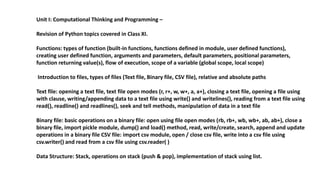



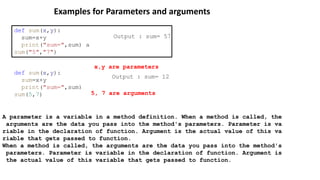
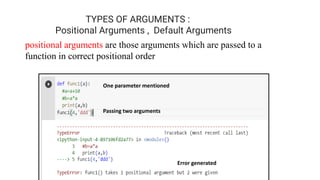
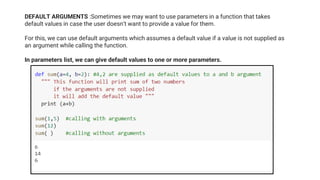
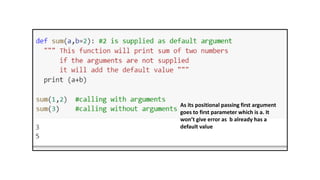

![Returning values from a function
Return statement is used to return a value from a function
A return statement is used to end the execution of the function call and ŌĆ£returnsŌĆØ
the result
(value of the expression following the return keyword) to the caller. The statements
after the return statements are not executed. If the return statement is without any
expression, then the special value None is returned.
A return statement is overall used to invoke a function so that the passed
statements can be executed.
def fun():
statements
. .
return [expression]
fun()](https://image.slidesharecdn.com/userdefinedfunctionsbriefexplaination-230417065011-e281bb88/85/Userdefined-functions-brief-explaination-pdf-11-320.jpg)




